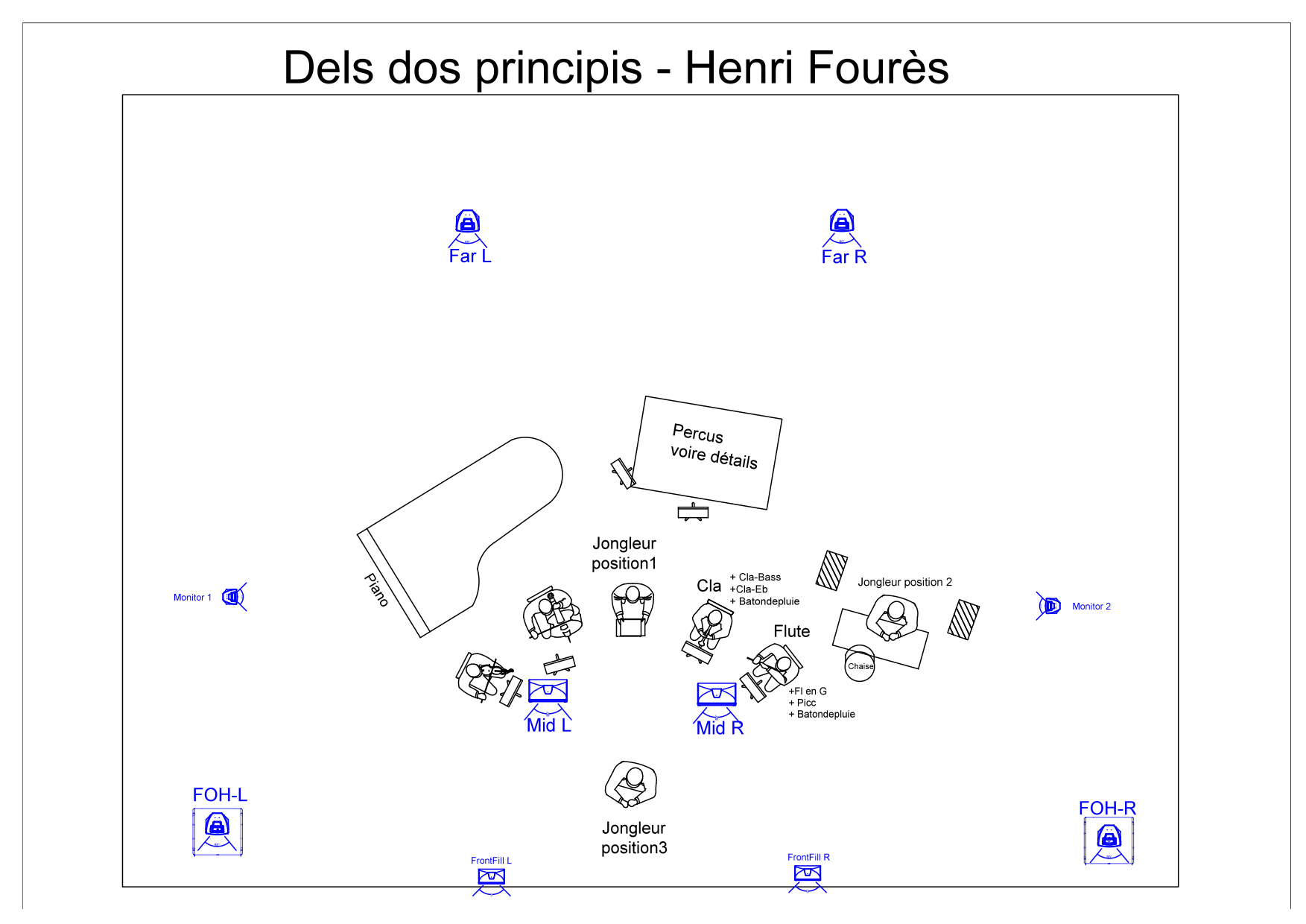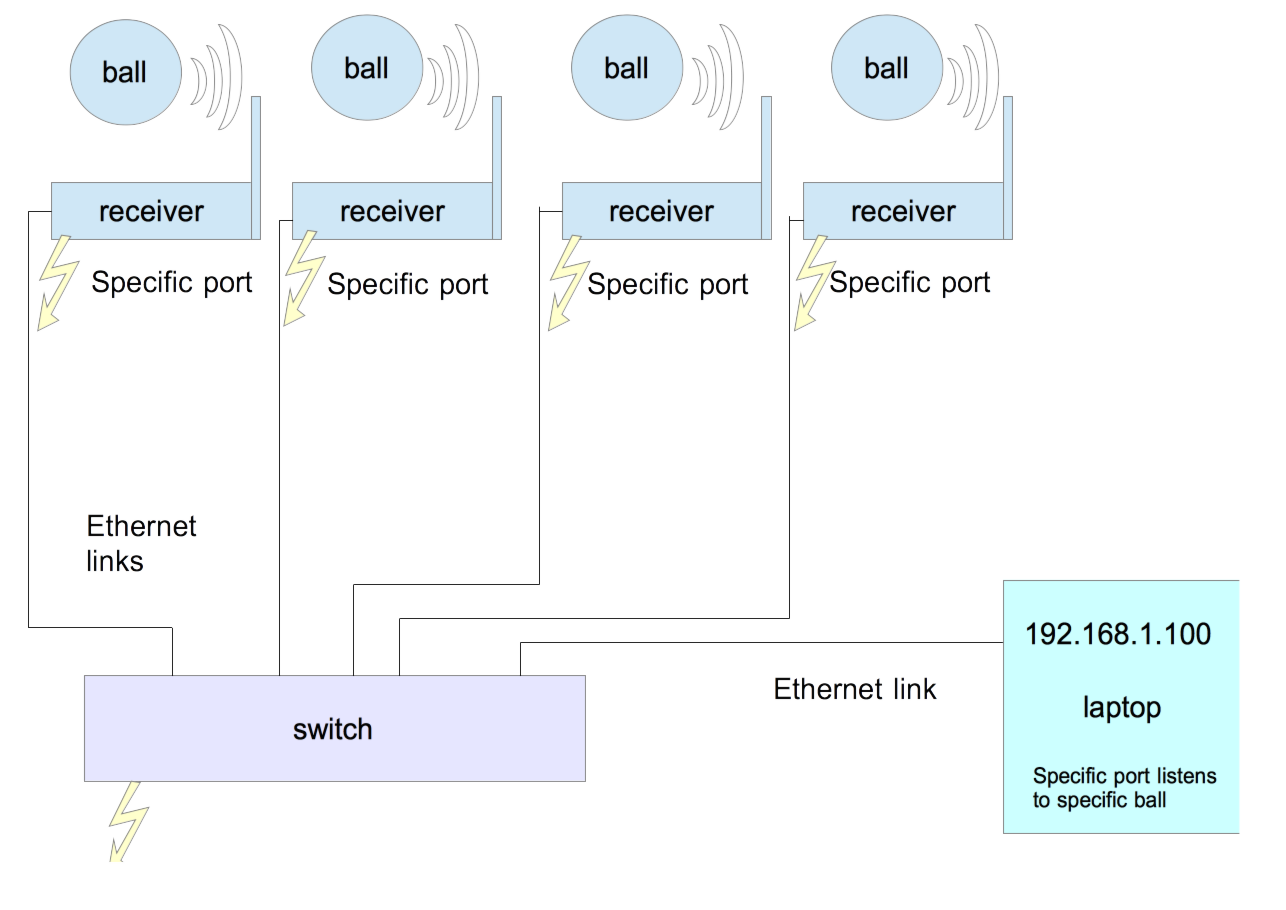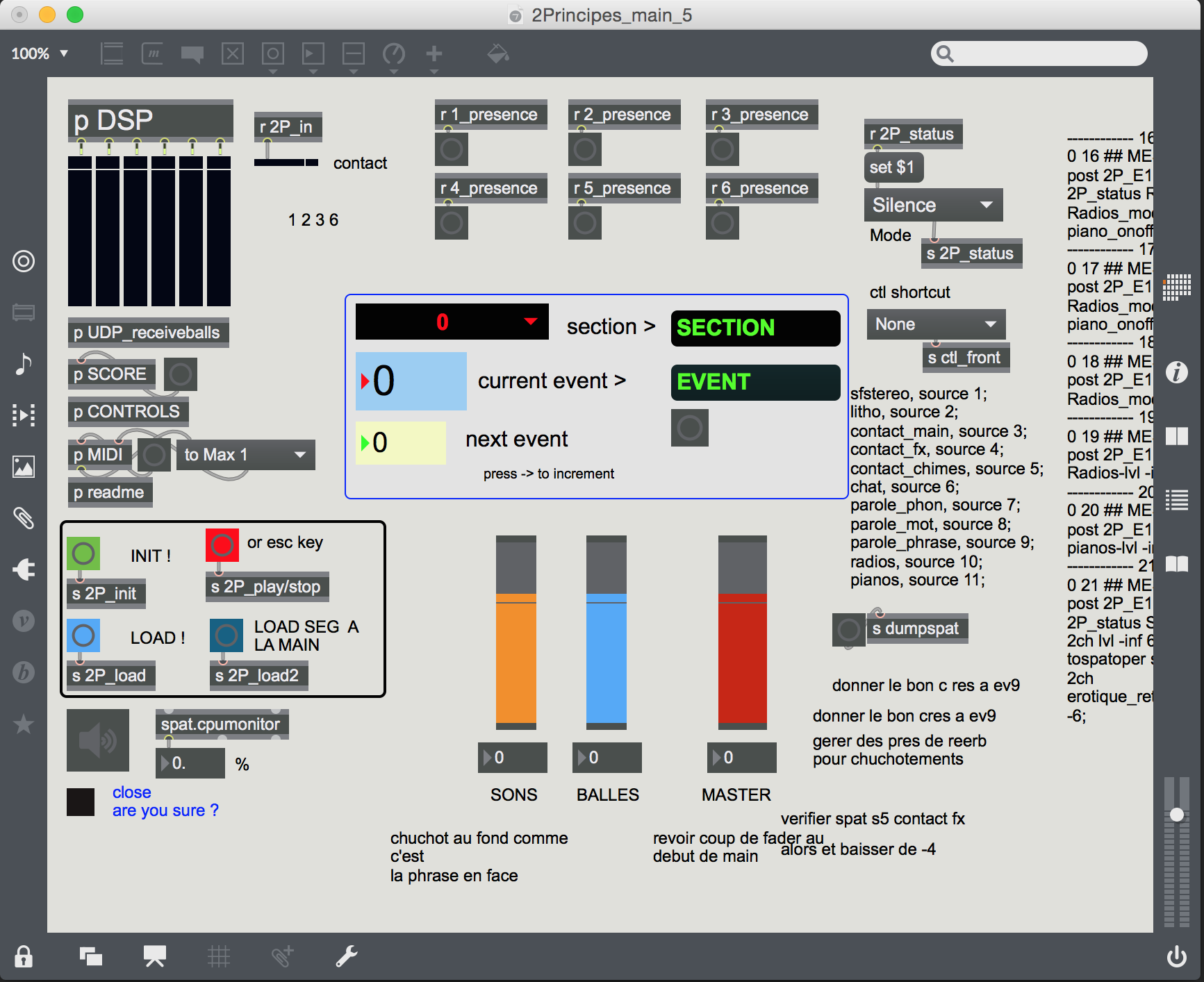Table of contents
Performance date: 30 septembre 2015 - First performance
Documentation date: 30 novembre 2015
Version state
Valid
Validation date: 3 mai 2018
Executions dates of this version
- 30 septembre 2015,
Version documentalist
- muller (Augustin.Muller@ircam.fr)
Version realisation
- Augustin Muller (Computer Music Designer)
- Jérémie Henrot (Sound engineer)
Upgrade Motivation
creation
Other version(s)
Detailed staff
- soliste : jongleur
- flûte (aussi bâton de pluie), clarinette basse (aussi bâton de pluie), percussionniste, piano, violon, violoncelle
Electronic equipment list
Computer Music Equipment
-
1 MacBook Pro - Apple Laptops
(Apple)
running Max 7 32bits (FTM) and Max 7 64bits (main patch) -
2 Max 7 - Max
(Cycling74)
-
1 ftm - Library
(Ircam)
version 2.6.0 -
1 Ircam Spat - Library
(Ircam)
version 4.7 -
1 Fireface 800 - Sound Board
(RME)
-
1 BCF 2000 - MIDI Mixer
(Behringer)
Audio Equipment
-
1 contact microphone - Contact Microphones
(Accusound)
on table -
6 Loudspeaker - Loudspeakers
-
2 subwoofer - Subwoofers
Musical Instruments
-
4 Smart juggling ball - Motion Capture
(Ircam)
using ircam WiMo technology -
4 Ethersense - Captation
(Ircam)
Smart Juggling Balls
Work related information
Premiere
- 30 septembre 2015, Festival Musica, Strasbourg
Publisher :
- Symétrie
Realisation
- Augustin Muller
Work length
- 32 mn
Useful links on Brahms
- Dels dos principis pour jongleur et ensemble de six musiciens (2014-2015), 32mn
- Henry Fourès
| File | Author(s) | Comment | |
|---|---|---|---|
| Download [1,2 Gio] | All-in-one Patch | Augustin Muller | All. Except Spat & FTM |
| Download [12,0 Mio] | Other FTM lib | Ircam | |
| Download [32,1 Kio] | Document Microphone Patch | Jeremie Henrot | mixing desk input patch used in Strasbourg |
| Download [214,0 Mio] | Other Spat Lib | Ircam |
Instructions
"Dels dos principis" is a septet with a juggler.
The instruments are to be slightly amplified and reverberated to balance with the electronics.
The line-up is : violin, cello, clarinet, flute, piano, percussion, and a juggler.
The juggler performance is requiring at least 4 custom juggling balls , "smart balls", with MoNano sensors. A contact mic on a table is also used.
Communication of equiped balls is done using zigbee radio, then ethernet cables to the electronics computer.
No real time treatments is done on the instruments.
Cues are triggered on the computer for interaction strategies and tape triggering.
Audio Setup :
The Max patch generates 8 channels of electronics sent through the mixing desk to the loudspeakers (Lointain L Lointain R, Wedge L, Wedge R, Face L, Face R, Sub L, Sub R)
The Max patch receives only a monophonic audio input, the contact mic placed on the table.
We worked at 48000 kHz with RME FF800 interface.
Loudspeaker setup :
The loudspeaker setup consists in a stereo face diffusion for amplification and electronics, 2 loudspeakers on stage (wedge position) for electronics
and 2 loudspeakers at far stage on stands above the musicians for electronics.
Stage setup :

Midi Setup :
No midi from stage.
We used a bcf controller to mix the DSP patch during performance.
A specific control was used to control the polyphony parameters and the organ sound proportion in the lithophone samplor patch.
cf specific control number in midi subsection of the patch.
Software installation :
- Put the whole 2principes_musica_main folder in your search path
- Spat 4.7 is needed in your packages
- FTM.2.6.0 is needed as well
- Run Max7 32 bits for 2principes_monitor
- Run Max7 64 bits for 2principes_main
to launch 2 max7 apps, copy paste the max app. Then get info on each, and specify check open in 32 bits for one, uncheck in the other.
After launching each instances, check bit depth in "about max"
The two applications communicate by OSC on a localhost port.
System Calibration and tests :
- Smart balls batteries must be charged ! (plug the usb pin and turn on switch to exterior side)
- Connect the receivers to the midi switch, and then the switch to the computer as follows :

- the IP address of the receiving computer MUST be 192.168.1.100.
- Launch 2principes_monitor patch in Max7 32 bits (as it needs FTM library). Once everything is connected and the patch launched, unplug the smart balls and push the connector to the OFF position (inside) then to ON again (outside). Movements should appear in the multisliders. You can check the balls kick calibration by turning "makesomenoise" patch on (uses terminal "say" command). Identify each ball you will use ! :
Ball 1 is used for the contact stuff.
Ball 1 & 2 are used for pattes de chat
Ball 1, 2 and 3 are used for parole juggling.
All are used for the radio section.
at the beginning, balls 1 & 2 are place in the piano.
3 is hidden on the floor near the central chair.
4 is already at the table.

Initialization routine :
- Check the assignation in 2principes_monitor "sendviaudp" section : there are 6 mo_input, but only 4 balls are used. This is for spare and swap possibilities. Edit it if you need!
- Launch Max 7 64 bits application and open the patch 2_principes_main. Check Max window for errors.
- Check that both application communicate and that the presence indicator is blinking.
- check the spat in ctrlshortcut menu, spat.
- ckeck the mix of soundfiles in ctrlshortcut menu, players.
- check the adc contact mic input, and scale the threshold for peak detection. Thresh is setup in ctl shortcut "litho", init message.
- INIT, Load. Wait for results in max window, then hit 2P_Load2 "LOAD SEG A LA MAIN" ( Check results as well).
- Place the menu on section 1 until next event is 1. You're ready to go.
Recommanded IO status : FS = 48000 kHz. IO vs 256, Sig vs 128 ; Overdrive ON. Audio Interrupt OFF
Patch Presentation :
The 2principes_monitor patch in the input receiver for smart balls. Each mo_input abstraction takes a port number as an argument, which correspond to the port indicated on the specific receiver, so it listens to a specific ball. Calibration has been done for each ball and is saved in a text file. It can be done again using the menu if needed.
It uses FTM, (that is why it's 32 bits for the time being).
The monitor sends smart balls data to the main patch by udp using localhost address.
The 2principes_main patch is the main DSP patch. It is "cue" based, but some parts must be followed manually with a midi mixer, especially the lithophone part where polyphony and organ sounds amount are to be mixed live. The cues are triggerd by hand from the FOH (right arrow key) : some sounds are played, juggling strategies are activated/de-activated and levels are adjusted. Each strategy corresponds to a status in the status menu (2P_status receive) and to a control panel.
Many sounds are loaded !: 64 bits only !

It has 1 audio input, the contact mic on the table for peak (bounce) detection, and 6 audio outputs : FarL, Far R, StageL, StageR, FaceL, FaceR, SubL, SubR.
The DSP section is where all signal processing is done (mainly playing samples in various different ways)
The UDP_receiveballs is where the network comm. is made.
The SCORE section is where the qlist is. Score is a textfile, qlist style.
The CONTROLS section is where all the controls are made ; you'll find the INIT parameter of each strategy in each control subpatch.
the MIDI section is for the BCF mapping.
Performance Notes :
Refer to electronic score for precise information.
Try to find clear balance of the juggling balls : as the sounds are often instrumental, do not hesitate to work with spat positions to clearly focus on the juggler.
The Irizina scream at the end of the lithos, (Evt 15) and the organ sound before (Evt 14) are the electronics climax of the piece.
The pianos in the radios section must mix with the acoustic piano.
The sub Output is used only for the contact part and fine control of the low end.
juggling strategies (with smart balls or contact mic) :
1st strategy : Contact Ball juggling on ball 1. Rotation of the ball modifies running sounds and scrubs in a buffer. High energy moves result in spatial moves too.
2nd strategy : "Patte de chat" : balls 1 & 2 trig samples when they are hard kicked (threshold adjustment in control section)
3rd strategy : Acceleration, phrases when they are thrown and are spinning with enough energy and for enough time ; see ctl patch and init message for thresholds.
4th strategy : "lithophones". Contact mic is used for triggering lithophones samples. Some organ samples are to be mixed according to the score, and the polyphony of the sampler increases (causing space changes)
5th strategy : "Radios-Pianos". 4 rolling balls on table results in hearing 4 radio stations. The first mode, "pyramid" is only noise. Then, radio-mode are actual radio station with partly intelligible speech. Zspins (rolling around the vertical axis) triggers and modulates piano samples.
© IRCAM

This documentation is licensed under a Creative Commons Attribution-NonCommercial-NoDerivatives 4.0 International License.
Program note
Je connais depuis longtemps le jongleur Jérôme Thomas. Nous avons joué ensemble, dans les années 90, au sein d’un trio piano, jonglage et percussion que nous formions avec le tambouriniste Carlo Rizzo. L’une des créations du trio fut programmée au Festival Musica de Strasbourg en 1998. J’ai par ailleurs invité Jérôme Thomas à participer depuis à plusieurs de mes créations dont « Le livre des traditions » pour octuor ; œuvre qui nous fut commandée conjointement avec Luc Ferrari par la WDR de Cologne.
Ces expériences mettaient en jeu deux lignes qui ne cessent de m’animer : d’une part le travail commun en « atelier » où se croisent des personnalités, des traditions, des manières d’inventer et des disciplines d’ordinaire séparées ; d’autre part la question de l’écriture du geste, en l’occurrence du geste jonglé, intégrée dans la composition à l’égal des autres parties instrumentales. Il était logique que ces « recherches » se développent un jour, par le truchement des nouveaux outils technologiques et de l’informatique musicale, dans une forme plus intégrée, où les caractéristiques gestuelles puissent être traduites, manipulées, « composées » en une véritable partition de musique de chambre.
Ce qui n’était pas possible alors, le devient aujourd’hui. Concevoir un nouveau projet d’écriture où l’un des arts du cirque, le jonglage, considéré pour sa musicalité – non seulement celle du geste lui-même mais aussi celle du résultat sonore qu’il produit grâce aux balles augmentées de capteurs – s’insère dans un ensemble de six musiciens, ceux de « L’instant donné » habitués à jouer sans chef, m’est alors apparu comme une étape naturelle de ce compagnonnage depuis longtemps engagé avec la créativité et la curiosité d’esprit de Jérôme Thomas.
Les données fournies par les capteurs de mouvement embarqués dans les différentes balles, et dans d’autres objets manipulés par le jongleur, sont le préalable à l’écriture d’une partition.
Selon les possibilités de reconnaissance de la position des balles dans l’espace, de contrôle des divers paramètres et de « sonification » des mouvements, – qui ont fait l’objet de la phase de recherche en ateliers à l’Ircam – des matériaux sonores viennent structurer « l’orchestration » d’un espace électro-acoustique joué par le jongleur à travers des haut-parleurs placés sur scène, et formant une scénographie de l’écoute et du regard où le corps est à l’avant-garde.
Par ailleurs, l’écriture pour les six musiciens de l’ensemble, qui ne fait, elle, intervenir aucun support technologique, dessine un espace acoustique propre. De fait, les rapports entre ces deux espaces apparaissent comme l’élément constitutif de la dramaturgie de la pièce. On « voit », certes, les outils du jongleur, leur manipulation et la gestuelle qui les anime, mais l’espace du concert, leur confère une sorte de « devenir instrumental ».
Dès lors leur statut est moins celui d’une traduction, d’une illustration ou d’un parallélisme virtuose entre le son et le geste, que celui d’une circulation d’énergie du geste vers le son, comme si naissait sous nos yeux, mais pour nos oreilles, un langage du corps tendu vers l’expression de la forme musicale où il est pris.
Ce n’est pas le jongleur qui « déclenche » par son action l’espace sonore (fragments de textes, sons électroniques ou instrumentaux), mais bien le mouvement des balles – principe d’indétermination – ou des objets, qui composent conjointement cet espace acoustique dans l’espace visuel.
En d’autres termes, ce n’est pas le geste qui déclenche ou modèle le son mais son résultat.
Henry Fourès.
Version documentation creation date: 30 novembre 2015 05:49, update date: 24 mars 2021 15:01